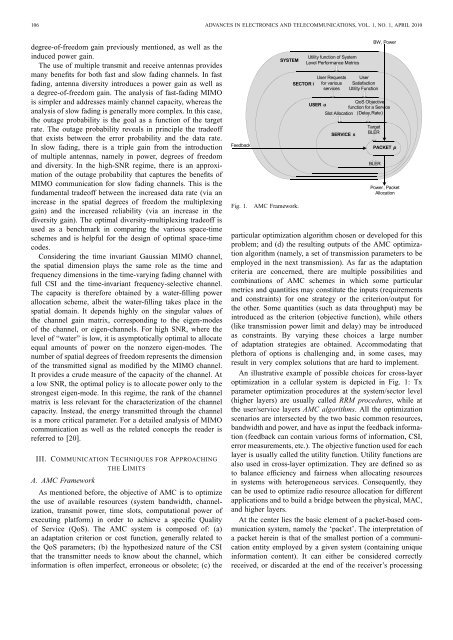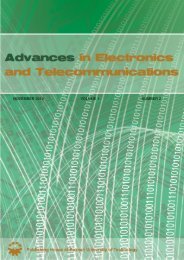channel - Advances in Electronics and Telecommunications
channel - Advances in Electronics and Telecommunications
channel - Advances in Electronics and Telecommunications
Create successful ePaper yourself
Turn your PDF publications into a flip-book with our unique Google optimized e-Paper software.
106 ADVANCES IN ELECTRONICS AND TELECOMMUNICATIONS, VOL. 1, NO. 1, APRIL 2010<br />
degree-of-freedom ga<strong>in</strong> previously mentioned, as well as the<br />
<strong>in</strong>duced power ga<strong>in</strong>.<br />
The use of multiple transmit <strong>and</strong> receive antennas provides<br />
many benefits for both fast <strong>and</strong> slow fad<strong>in</strong>g <strong>channel</strong>s. In fast<br />
fad<strong>in</strong>g, antenna diversity <strong>in</strong>troduces a power ga<strong>in</strong> as well as<br />
a degree-of-freedom ga<strong>in</strong>. The analysis of fast-fad<strong>in</strong>g MIMO<br />
is simpler <strong>and</strong> addresses ma<strong>in</strong>ly <strong>channel</strong> capacity, whereas the<br />
analysis of slow fad<strong>in</strong>g is generally more complex. In this case,<br />
the outage probability is the goal as a function of the target<br />
rate. The outage probability reveals <strong>in</strong> pr<strong>in</strong>ciple the tradeoff<br />
that exists between the error probability <strong>and</strong> the data rate.<br />
In slow fad<strong>in</strong>g, there is a triple ga<strong>in</strong> from the <strong>in</strong>troduction<br />
of multiple antennas, namely <strong>in</strong> power, degrees of freedom<br />
<strong>and</strong> diversity. In the high-SNR regime, there is an approximation<br />
of the outage probability that captures the benefits of<br />
MIMO communication for slow fad<strong>in</strong>g <strong>channel</strong>s. This is the<br />
fundamental tradeoff between the <strong>in</strong>creased data rate (via an<br />
<strong>in</strong>crease <strong>in</strong> the spatial degrees of freedom the multiplex<strong>in</strong>g<br />
ga<strong>in</strong>) <strong>and</strong> the <strong>in</strong>creased reliability (via an <strong>in</strong>crease <strong>in</strong> the<br />
diversity ga<strong>in</strong>). The optimal diversity-multiplex<strong>in</strong>g tradeoff is<br />
used as a benchmark <strong>in</strong> compar<strong>in</strong>g the various space-time<br />
schemes <strong>and</strong> is helpful for the design of optimal space-time<br />
codes.<br />
Consider<strong>in</strong>g the time <strong>in</strong>variant Gaussian MIMO <strong>channel</strong>,<br />
the spatial dimension plays the same role as the time <strong>and</strong><br />
frequency dimensions <strong>in</strong> the time-vary<strong>in</strong>g fad<strong>in</strong>g <strong>channel</strong> with<br />
full CSI <strong>and</strong> the time-<strong>in</strong>variant frequency-selective <strong>channel</strong>.<br />
The capacity is therefore obta<strong>in</strong>ed by a water-fill<strong>in</strong>g power<br />
allocation scheme, albeit the water-fill<strong>in</strong>g takes place <strong>in</strong> the<br />
spatial doma<strong>in</strong>. It depends highly on the s<strong>in</strong>gular values of<br />
the <strong>channel</strong> ga<strong>in</strong> matrix, correspond<strong>in</strong>g to the eigen-modes<br />
of the <strong>channel</strong>, or eigen-<strong>channel</strong>s. For high SNR, where the<br />
level of “water” is low, it is asymptotically optimal to allocate<br />
equal amounts of power on the nonzero eigen-modes. The<br />
number of spatial degrees of freedom represents the dimension<br />
of the transmitted signal as modified by the MIMO <strong>channel</strong>.<br />
It provides a crude measure of the capacity of the <strong>channel</strong>. At<br />
a low SNR, the optimal policy is to allocate power only to the<br />
strongest eigen-mode. In this regime, the rank of the <strong>channel</strong><br />
matrix is less relevant for the characterization of the <strong>channel</strong><br />
capacity. Instead, the energy transmitted through the <strong>channel</strong><br />
is a more critical parameter. For a detailed analysis of MIMO<br />
communication as well as the related concepts the reader is<br />
referred to [20].<br />
III. COMMUNICATION TECHNIQUES FOR APPROACHING<br />
A. AMC Framework<br />
THE LIMITS<br />
As mentioned before, the objective of AMC is to optimize<br />
the use of available resources (system b<strong>and</strong>width, <strong>channel</strong>ization,<br />
transmit power, time slots, computational power of<br />
execut<strong>in</strong>g platform) <strong>in</strong> order to achieve a specific Quality<br />
of Service (QoS). The AMC system is composed of: (a)<br />
an adaptation criterion or cost function, generally related to<br />
the QoS parameters; (b) the hypothesized nature of the CSI<br />
that the transmitter needs to know about the <strong>channel</strong>, which<br />
<strong>in</strong>formation is often imperfect, erroneous or obsolete; (c) the<br />
��������<br />
������<br />
Fig. 1. AMC Framework.<br />
��������<br />
���������������������������<br />
�������������������������<br />
��������������<br />
������������<br />
��������<br />
����� �<br />
��������������<br />
�����������������������<br />
��������������� ������������<br />
�������� �<br />
�����<br />
�������������<br />
����������������<br />
���������<br />
�������<br />
����<br />
������� �<br />
����<br />
�������������<br />
����������<br />
particular optimization algorithm chosen or developed for this<br />
problem; <strong>and</strong> (d) the result<strong>in</strong>g outputs of the AMC optimization<br />
algorithm (namely, a set of transmission parameters to be<br />
employed <strong>in</strong> the next transmission). As far as the adaptation<br />
criteria are concerned, there are multiple possibilities <strong>and</strong><br />
comb<strong>in</strong>ations of AMC schemes <strong>in</strong> which some particular<br />
metrics <strong>and</strong> quantities may constitute the <strong>in</strong>puts (requirements<br />
<strong>and</strong> constra<strong>in</strong>ts) for one strategy or the criterion/output for<br />
the other. Some quantities (such as data throughput) may be<br />
<strong>in</strong>troduced as the criterion (objective function), while others<br />
(like transmission power limit <strong>and</strong> delay) may be <strong>in</strong>troduced<br />
as constra<strong>in</strong>ts. By vary<strong>in</strong>g these choices a large number<br />
of adaptation strategies are obta<strong>in</strong>ed. Accommodat<strong>in</strong>g that<br />
plethora of options is challeng<strong>in</strong>g <strong>and</strong>, <strong>in</strong> some cases, may<br />
result <strong>in</strong> very complex solutions that are hard to implement.<br />
An illustrative example of possible choices for cross-layer<br />
optimization <strong>in</strong> a cellular system is depicted <strong>in</strong> Fig. 1: Tx<br />
parameter optimization procedures at the system/sector level<br />
(higher layers) are usually called RRM procedures, while at<br />
the user/service layers AMC algorithms. All the optimization<br />
scenarios are <strong>in</strong>tersected by the two basic common resources,<br />
b<strong>and</strong>width <strong>and</strong> power, <strong>and</strong> have as <strong>in</strong>put the feedback <strong>in</strong>formation<br />
(feedback can conta<strong>in</strong> various forms of <strong>in</strong>formation, CSI,<br />
error measurements, etc.). The objective function used for each<br />
layer is usually called the utility function. Utility functions are<br />
also used <strong>in</strong> cross-layer optimization. They are def<strong>in</strong>ed so as<br />
to balance efficiency <strong>and</strong> fairness when allocat<strong>in</strong>g resources<br />
<strong>in</strong> systems with heterogeneous services. Consequently, they<br />
can be used to optimize radio resource allocation for different<br />
applications <strong>and</strong> to build a bridge between the physical, MAC,<br />
<strong>and</strong> higher layers.<br />
At the center lies the basic element of a packet-based communication<br />
system, namely the ‘packet’. The <strong>in</strong>terpretation of<br />
a packet here<strong>in</strong> is that of the smallest portion of a communication<br />
entity employed by a given system (conta<strong>in</strong><strong>in</strong>g unique<br />
<strong>in</strong>formation content). It can either be considered correctly<br />
received, or discarded at the end of the receiver’s process<strong>in</strong>g







